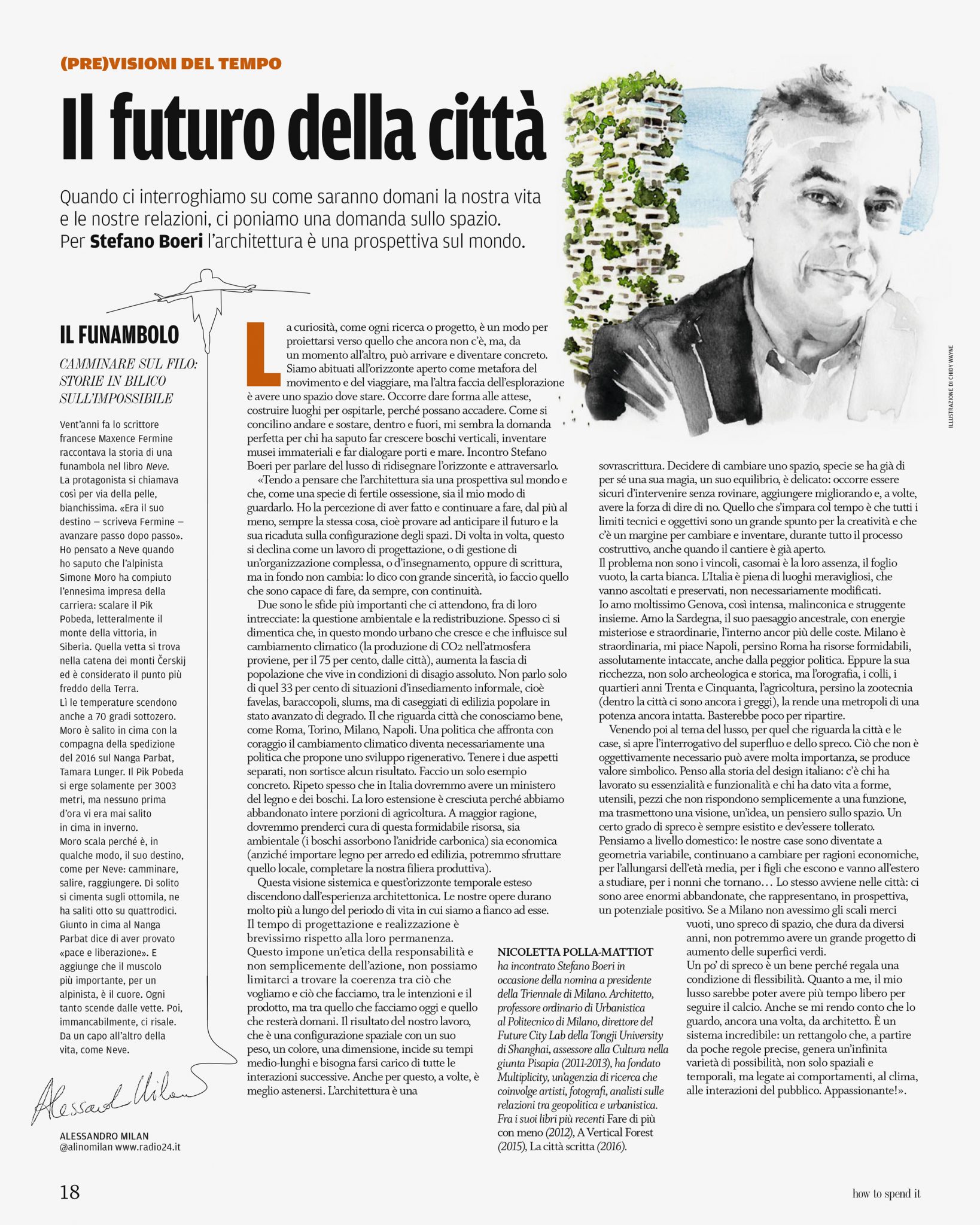
When we question ourselves about how our lives and relationships will change tomorrow, we think of space. For Stefano Boeri, architecture is a perspective on the world.
In his interview to “Il Sole 24 ore” Stefano Boeri speaks about luxury of redesigning the skyline and going through it.
“I tend to think that architecture is a perspective on the world and that, as a sort of fertile obsession, it is my way of looking at it. I have the perception that I have done and keep doing, from the most to the least, always the same thing, that is to try to anticipate the future and its influence on the configuration of the spaces. From time to time, it becomes a work of planning, or managing a complex organization, or teaching, or writing, but basically it does not change: I say it with great sincerity, I do what I can to do, always, with continuity.
The most important challenges that await us, intertwined one with another: the environmental issue and the redistribution. We often forget that, in this urban world that is growing and influencing climate change (the production of CO2 in the atmosphere comes, for 75 percent, from cities), the population that lives in conditions of absolute discomfort increases. I do not speak only of that 33 percent of informal settlement situations, the favelas, slums, but of tenements of popular housing in an advanced state of decay. This concerns also the well known cities, such as Rome, Turin, Milan, Naples. A policy that courageously tackles climate change necessarily becomes a policy that proposes regenerative development. Keeping the two aspects separate brings no result. I make only one concrete example. I often repeat that in Italy we should have a ministry of wood and forests. Their surface is increasingly extending because we have abandoned entire portions of agriculture. A fortiori, we should take care of this formidable resource, both environmental (forests absorb carbon dioxide) and economic (rather than importing wood for furniture and construction, we could take advantage of the local materials, thus completing our production chain).
This systemic vision and this extended time horizon derive from the architectural experience.
Our works last much longer than the period of life in which we can witness them. The design and construction time is very short compared to their permanence. This imposes an ethics of responsibility and not simply for the action, we can not limit ourselves to find the coherence between what we want and what we do, between intentions and the product, but between what we do today and what will remain tomorrow.
The result of our work, which is a spatial configuration with its weight, color, dimension, affects medium-long times and must take charge of all subsequent interactions. Also for this reason, sometimes it is better to abstain. Architecture is an overwriting. Decision to change a space, especially if it already has its own magic, its balance, is delicate: you need to be sure to intervene without ruining, adding improving and, sometimes, having the strength to say no. What we learn over time is that all technical and objective limits are a great starting point for creativity and that
there is a margin to change and invent, throughout the construction process, even when the building site is already open.
The problem is not the constraints, but the absence of such, the empty sheet, the tabula rasa.
Italy is full of wonderful places, that we must be heard and preserved, not necessarily modified. I love Genoa so much, it is so intense, melancholic and poignant at the same time. I love Sardinia, its ancestral landscape, with mysterious and extraordinary energies, the dryland even more than the coasts. Milan is extraordinary, I like Naples, even Rome has formidable resources, absolutely undamaged, even by the worst politics. Yet its wealth, not only archaeological and historical, but the orography, the hills, the thirties and fifties, agriculture, even animal husbandry (there are still flocks in the city), makes it a metropolis of a still intact power. It wouldn’t take much to restart.
Coming then to the theme of luxury, regarding the city and the houses, the question of the superfluous and the waste opens up. What is not objectively necessary can have great importance if it produces symbolic value. I think of the history of Italian design: some have worked on essentiality and functionality while the others have given life to shapes, tools, pieces that do not simply respond to a function, but transmit a vision, an idea, a thought about space. A certain degree of waste has always existed and must be tolerated. We think at the domestic level: our homes have become variable geometry, they continue to change due to economic reasons, to the increase of the average age, to the children who go out and abroad to study, for the grandparents who come back … it happens in cities: there are huge abandoned areas, which represent, in perspective, a positive potential. If in Milan we did not have empty railway yards, a waste of space, which lasted for several years, we could not have a big project to increase the green areas. A little waste is good because it offers a condition of flexibility. As for me, my luxury would be to have more spare time to follow football. Although I realize that I look at him, once again, as an architect. It is an incredible system: a rectangle that, starting from a few precise rules, generates an infinite variety of possibilities, not only spatial and temporal, but linked to behavior, to the climate, to the interactions of the public. Exciting! ”
